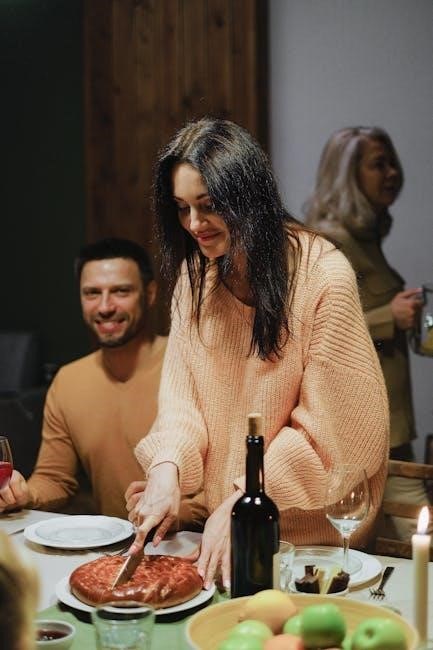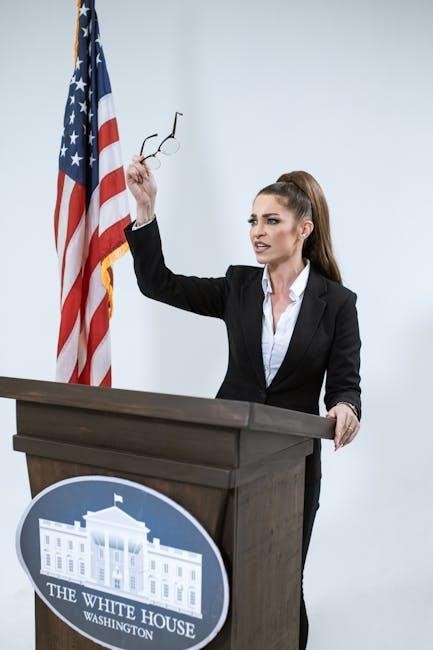Roles and Responsibilities of a Roastmaster
A roastmaster, often referred to as an emcee, serves as the host and conductor of a comedic takedown event. Their primary role is to engage the audience, deliver clever jokes, and maintain a balance between humor and respect. The roastmaster must charisma, timing, and the ability to think on their feet, ensuring the event remains entertaining while honoring the guest of honor. Their responsibilities include setting the tone, managing the flow, and keeping the audience laughing without crossing boundaries. Essentially, they are the master of ceremonies, blending wit and charm to create a memorable experience.
Understanding the Audience
Understanding the audience is a critical aspect of a roastmaster’s role, as it ensures the humor resonates without causing offense. A skilled roastmaster must gauge the audience’s preferences, cultural background, and sensitivities to tailor the jokes appropriately. This involves observing demographics, such as age and profession, to align the content with their experiences and interests. The roastmaster must also assess the audience’s mood and energy, adjusting the tone and pacing to keep them engaged. Additionally, they must be aware of any sensitive topics that could alienate or upset the crowd, striking a balance between humor and respect. By understanding the audience, the roastmaster can deliver jokes that are relatable, inclusive, and impactful, ensuring the event remains enjoyable for everyone involved. This ability to read and adapt to the audience is what distinguishes a great roastmaster from a good one.

Preparation for the Roast
Preparation is key to a successful roast. The roastmaster must draft tailored jokes, plan the flow, and research the guest’s background. Staying informed about current events and the guest’s latest activities ensures relevance. Rehearsing delivery is also crucial.
Researching the Guest of Honor
Researching the guest of honor is a critical step in preparing for a roast. Understanding their background, achievements, and public persona allows the roastmaster to craft personalized jokes that resonate. This involves gathering information about their career milestones, personal life, and any controversies they’ve been involved in. By studying their public image, the host can identify areas to poke fun at while maintaining respect. For instance, knowing their notable works or public statements helps in creating targeted humor. Additionally, staying updated on current events related to the guest ensures the jokes remain relevant and timely. The goal is to strike a balance between humor and admiration, making the roast both entertaining and honoring. Effective research ensures the roastmaster can connect with the audience and deliver jokes that are both funny and appropriate. This step is foundational to the success of the event, as it allows the host to tailor the content to the guest’s unique profile.
Crafting Appropriate Jokes
Crafting appropriate jokes is essential for a roastmaster to ensure humor aligns with the event’s tone. The jokes should be witty, yet respectful, avoiding offensive or sensitive topics. Understanding the audience and the guest of honor’s personality helps tailor the humor. Researching the guest’s background, career, and public image provides material for personalized jokes. Wordplay, puns, and clever twists are effective tools to keep the jokes engaging. Timing and delivery are crucial, as the roastmaster must balance humor with admiration. Avoiding overly harsh or personal attacks maintains the roast’s lighthearted nature. The jokes should highlight the guest’s quirks or achievements in a playful manner, ensuring the audience laughs while the guest feels honored. Crafting jokes requires creativity, empathy, and a deep understanding of the context. By blending humor with respect, the roastmaster creates an entertaining yet dignified experience. This step is vital to the success of the roast, as it reflects the host’s skill in navigating humor and sensitivity. Well-crafted jokes make the event memorable and enjoyable for everyone involved.

Delivery Techniques
Effective delivery techniques involve charisma, timing, and audience engagement. A roastmaster must balance humor with respect, ensuring jokes land without offense. Clear enunciation, confident posture, and expressive gestures enhance performance. Reading the room and adapting tone maintains connection, keeping the audience entertained and the guest honored. Delivery is key to a successful roast, blending humor with admiration seamlessly. A skilled roastmaster knows when to pause, when to emphasize, and how to navigate audience reactions. This art of delivery transforms a roast into a memorable experience, showcasing both the host’s talent and the guest’s resilience. It’s about finding the perfect balance between wit and warmth.
Importance of Timing and Tone
Timing and tone are crucial elements in a roastmaster’s performance. Proper timing ensures jokes land effectively, while tone maintains the balance between humor and respect. A well-timed pause or a strategically placed punchline can enhance the comedic impact, keeping the audience engaged and laughing. Tone, on the other hand, helps navigate sensitive topics without causing offense. A roastmaster must adopt a playful yet respectful tone to honor the guest while delivering witty remarks. Misjudging either aspect can lead to awkward moments or unintended hurt feelings. Therefore, mastering timing and tone is essential for a successful roast, ensuring the event remains light-hearted and enjoyable for everyone involved. These skills require practice and a deep understanding of the audience and the guest of honor, making them fundamental to a roastmaster’s craft.
Strategies for Effective Audience Engagement
To engage the audience effectively, a roastmaster must employ strategic techniques that foster connection and participation. Understanding the audience’s demographics and preferences is key, as it allows tailored jokes and references. Interactive elements, such as polls or Q&A sessions, can also be used to involve the audience directly. Reading the room’s energy is crucial; a skilled roastmaster adjusts their delivery based on audience reactions. Using relatable humor and shared experiences ensures the content resonates widely. Incorporating storytelling or anecdotes about the guest of honor can create a sense of camaraderie. Encouraging audience participation through call-and-response or light-hearted challenges adds to the dynamic. Balancing humor with empathy is essential to avoid alienating anyone. Finally, ending on a high note leaves a lasting impression. By combining these strategies, a roastmaster can create an inclusive, entertaining, and memorable experience for everyone involved. These techniques require a blend of preparation, intuition, and adaptability, making them vital for successful audience engagement.

Handling Sensitive Topics
Handling sensitive topics is a delicate task for a roastmaster, requiring finesse and judgment to navigate without causing offense. The key is to identify boundaries and avoid crossing them, ensuring humor remains respectful. Self-awareness is crucial; understanding one’s own limits and the audience’s sensitivities helps in crafting appropriate jokes. Relatability is another factor—jokes should be relevant to the guest and audience without targeting vulnerable subjects. Timing and delivery play a significant role; a well-timed joke can diffuse tension, while a poorly timed one can escalate it. Empathy is essential; considering the impact of words on individuals and groups prevents hurtful remarks. A roastmaster must balance humor with kindness, ensuring the roast remains lighthearted. Preparation is vital—researching the guest’s background helps in identifying off-limits topics. Trusting instincts is also important; if a joke feels off, it’s better to avoid it. Lastly, ending on a positive note reinforces goodwill. By prioritizing respect and empathy, a roastmaster can address sensitive topics effectively, maintaining the event’s integrity and humor.

Learning from Famous Roastmasters
Studying famous roastmasters provides invaluable insights for mastering the art of comedic takedowns. Observing their techniques, such as Seth MacFarlane’s sharp wit or Jeff Garlin’s impeccable timing, can help refine one’s delivery. Notable figures like David Spade and Kevin Hart exemplify how to balance humor with respect, ensuring jokes land without crossing boundaries. Analyzing their performances reveals the importance of audience engagement, clever wordplay, and adaptability. Many successful roastmasters, including Jane Lynch and Seth Rogen, demonstrate how to navigate sensitive topics with grace, maintaining laughter while preserving dignity. Their strategies highlight the significance of preparation, understanding the audience, and staying attuned to the room’s energy. By emulating these masters, aspiring hosts can develop their unique style, blending humor with empathy to create memorable experiences. Learning from their approaches not only enhances comedic skills but also fosters confidence in handling the delicate balance of a roast. Ultimately, famous roastmasters serve as guides, offering practical lessons in the art of hosting a comedic takedown with flair and finesse.
Concluding the Roast
Effectively concluding a roast is crucial to leaving a lasting positive impression. The host should signal the end with a strong closing statement, often thanking the audience and the guest of honor. It’s important to shift from humor to sincerity, acknowledging the honoree’s contributions or qualities. A well-crafted final joke or heartfelt remark can tie the event together, ensuring it ends on a high note. Famous roastmasters like Seth MacFarlane and Jeff Garlin often use this moment to reinforce their connection with the audience while celebrating the guest. The conclusion should feel natural, avoiding abrupt endings or awkward pauses. The host’s ability to seamlessly transition from humor to appreciation is key. By ending with grace and humor, the roastmaster ensures the event is memorable and respectful, maintaining the balance between comedy and tribute. A strong finish reinforces the host’s skill and leaves the audience satisfied, making the conclusion as impactful as the roast itself.
